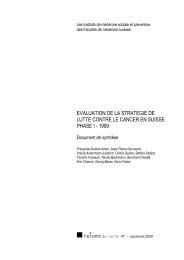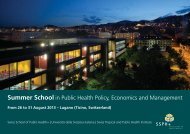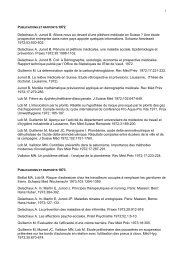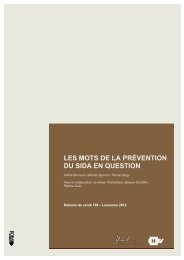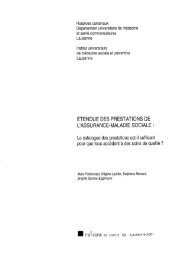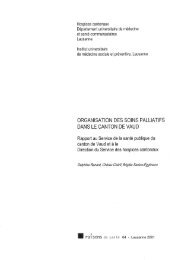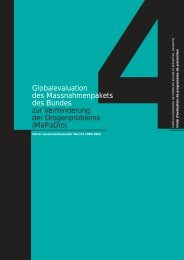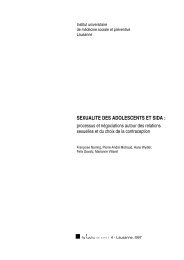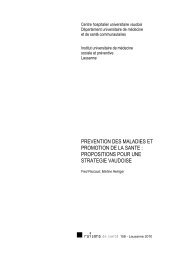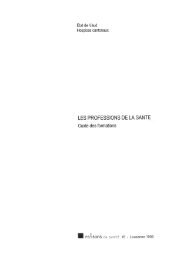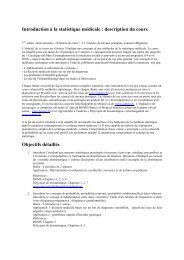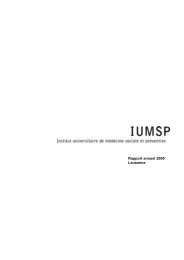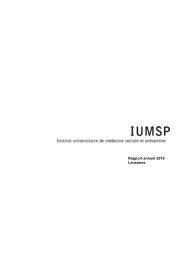Fortbildungen / Formations continues 2012 - IUMSP
Fortbildungen / Formations continues 2012 - IUMSP
Fortbildungen / Formations continues 2012 - IUMSP
Erfolgreiche ePaper selbst erstellen
Machen Sie aus Ihren PDF Publikationen ein blätterbares Flipbook mit unserer einzigartigen Google optimierten e-Paper Software.
50 years of EORTC<br />
Brussels 15-16 March <strong>2012</strong><br />
Franco Cavalli, Oncology Institute of Southern<br />
Switzerland, Bellinzona<br />
This conference, which was more of a celebration than a scienti�c<br />
meeting, was held in the beautiful Square–Brussels<br />
Meeting Centre, which is very conveniently located in the<br />
centre of Brussels, right between Central Station and Palais<br />
Royal.<br />
For two days, 1,100 people gathered to celebrate half a<br />
century of EORTC’s existence. The organisation was set<br />
up in 1962, at a time when the European dream was still<br />
a beautiful vision, which undoubtedly was shared by<br />
EORTC’s �rst presidents. Let’s name the �rst seven chairmen:<br />
Dr Georges Mathé, Prof. Silvio Garattini, Prof. Dirk<br />
Willem Van Bekkum, Prof. Henri Tagnon, Lazlo George<br />
Latja, Prof. Carl Gottfried Schmidt and Prof. Umberto<br />
Veronesi. This list reads like a who’s who of oncology in<br />
Europe.<br />
Admittedly, EORTC – or the EORTC headquarters in<br />
particular – may have become so large that productivity<br />
may have suffered. Nevertheless, EORTC remains a pillar<br />
of clinical cancer research in Europe. It is therefore with<br />
a certain pride that we impart the news that Prof. Roger<br />
Stupp will be the �rst Swiss national to become EORTC<br />
Chairman from 2013 until 2016. His appointment is not<br />
only a recognition for what he has done for EORTC, but<br />
also for the Swiss participation: Over the last 11 years,<br />
about 75,000 patients were enrolled into EORTC trials,<br />
1,500 of them in Switzerland. Our country is the largest<br />
non-EU contributor participating in EORTC activities<br />
with regard to the number of patients recruited into trials.<br />
In fact, Roger Stupp will be the �rst non-EU researcher to<br />
head EORTC.<br />
The presenters at the conference mainly focused on the<br />
organisation’s past achievements, but also outlined the<br />
future prospects. Dr Ruxandra Draghia-Akli, the Director<br />
of the Health Directorate at the Research DG of the<br />
European Commission, worked for many years in cancer<br />
research as a PhD and is very familiar with preclinical<br />
and clinical research. Summarising the current situation<br />
within the EU – although EORTC is not directly funded<br />
by the EU Commission – she explained that the EU<br />
Commission invests about €250 million every year into<br />
KONGRESSBERICHTE<br />
cancer research in Europe, whereby a quarter, the largest<br />
share, is devoted to ERC grants, while funding of clinical<br />
research is limited to about €35 million per year. (IOSI<br />
was the only Swiss oncology institute to recently having<br />
received such an ERC grant.) Overall, the EU Commission’s<br />
spending on cancer research amounts to about 10%<br />
of the total of all 27 EU countries’ annual investments.<br />
The EU decided to invest more in cancer research over the<br />
next decade, also in cooperation with the U.S., Japan and<br />
Australia. Most of the programme will be devoted to genomics<br />
and proteomics as well as so-called «personalised»<br />
medicine. Only the future can tell whether the current<br />
hype about the latter will prove to have been justi�ed.<br />
Probably more important is the fact that the EU is about<br />
to revise the clinical trial directive, which should be accepted<br />
this year in its revised form: it has been promised<br />
that this will mean a simpli�cation of the incredibly bureaucratic<br />
procedures, which after the acceptance of the<br />
currently valid clinical trials directive (2001) have led to<br />
a dramatic decrease of the number of clinical trials conducted<br />
in Europe (see box).<br />
Clinical trials in Europe<br />
2007: 5100<br />
2011: 3700<br />
In the meantime, the number of pages in the Consent<br />
Form has increased from 3 in 2000 to 12 pages in <strong>2012</strong>.<br />
This is the consequence of the clinical trials directive,<br />
which hopefully should be amended and accepted in<br />
its revised form in <strong>2012</strong>.<br />
Another conference highlight was the presentation on<br />
the late Prof. Henri Tagnon, which was held by Prof.<br />
Alexander Eggermont, the newly elected director of<br />
IGR-Villejuif. He discussed «The changing paradigm for<br />
melanoma care and research», highlighting the very impressive<br />
goals which have been achieved over the last 20<br />
years by the EORTC melanoma group. Then he concentrated<br />
mainly on the new treatment possibilities for this<br />
very particular type of cancer. He concluded his brilliant<br />
talk by highlighting the �nancial issues regarding current<br />
drug development: Should a triple combination become<br />
the standard treatment for melanoma (B-RAF-inhibitor/<br />
MEK-inhibitor/Ipilimumab) in the near future, it may<br />
cost as much as $300,000 per year! It is hard to envisage<br />
that even the richest countries of the world will be prepared<br />
to pay for a therapy at such an extortionate price.<br />
Schweizer Krebsbulletin � Nr. 2/<strong>2012</strong> 173



